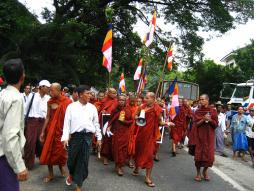Digital Democracy
Posted by admin on Nov 06, 2009
This article was written by Emily Jacobi from Digital Democracy. We are publishing her extensive report on Burmese dissidents' use of technology in three parts. Part I with an overview of mobiles in Burma is here and part II that describes cross-border dissident communications here. All names of individuals have been changed to protect their identity.
Cracks in the Fortress' Wall
It was May 2008 in Thailand, and Win Tun was anxiously watching his phone. Early May marks the beginning of rainy season, and reports were coming in of a major cyclone hitting Rangoon. A couple of days after the initial landfall on May 2, residual rains had made it to Thailand, and it was clear that Cyclone Nargis - “butterfly” - had destroyed major swaths of land in the Irawaddy delta. Up to 140,000 were missing or dead. Win Tun was worried about his family in Rangoon.
A former political prisoner, he spent 5 years in the infamous Insein prison for democratic activities in university in the ‘90s. When we met in early 2008, he had a sad air to him. Twenty years have passed since since the uprising of ’88, in which he was too young to participate. The exhaustion of fighting for something that seemed so far out of reach was wearing on him. Worse yet, he missed his family but couldn’t return home without bringing undue attention to them or risking another prison sentence.
After Nargis he was lucky. It took three days for him to get through to his family on their mobiles, and he learned they were okay – just upset, like most Burmese, at the government’s negligence of the victims. In the wake of Nargis, international aid groups waited in Thailand and offshore as the government refused to grant entrance to most.
The first few days after the Cyclone, bewildered Burmese in Rangoon stumbled out of their houses to survey the damage. In the streets, monks helped residents clear felled trees and downed power lines. But there were much bigger problems in the delta. Entire villages had been destroyed, and farmland had turned into swamps, contaminated by drowned bodies.
Posted by admin on Nov 03, 2009
This article was written by Emily Jacobi from Digital Democracy. We are publishing her extensive report on Burmese dissidents' use of technology in three parts. Names of individuals in this account have been changed to protect their identity.
Burma – a modern anomaly
In September 2007, Buddhist clergy in the Southeast Asian nation of Burma (also known as Myanmar) led hundreds of thousands of citizens in peaceful protest against the ruling military regime. Armed with camera phones and limited internet access, they coordinated the largest protests the country had seen in 19 years, and broadcast the story to the outside world. These tools proved so threatening that the Burmese government responded by shutting off all Internet and mobile phone communications for five days. Why is this significant?
Globally, mobile phone penetration has reached an estimated 4.6 billion subscribers by the end of 2009, more than half the world’s population. Yet in Burma, mobile phone usage remains the exception rather than the rule. Government-imposed barriers and prohibitive prices have kept mobile penetration to approximately 1% of the population, a rate comparable to Internet access in the country.
Burma’s technological isolation accompanies the country’s greater political isolation. Ruled by a military dictatorship since 1962, the nation has become increasingly estranged from the global community. Even the name, changed from Burma to Myanmar by the military government in 1989, is disputed around the world as well as among Burmese political groups. Economic sanctions have been leveled against the country by the US and EU for its human rights abuses, and The Economist ranked Burma163 out of 167 countries in its 2008 Democracy Index.
Burma’s ruling military junta does maintain business deals with neighboring countries including China and Thailand, but the nation lags far behind its neighbors economically and technologically. While there were only 610,000 mobile users in the country at the end of 2008 (1% of the population), India and China were expected to account for a quarter of global mobile penetration – approximately 1 billion subscriptions - by the beginning of the year, according to the ITU. In neighboring Thailand, meanwhile, approximately 92% of the population is covered by mobile telephony.
Compared to its neighbors, Burma’s mobile access seems woefully behind. Despite this, mobiles have played a critical role in crisis moments, such as the monk-led protests in 2007 and in coordinating recovery from the devastation of Cyclone Nargis in May 2008. Additionally, mobile availability in neighboring countries has been effectively harnessed by Burmese groups operating in the bordering countries, where an estimated 3.5 million Burmese have been displaced.

